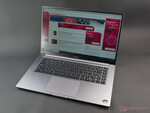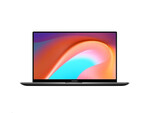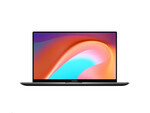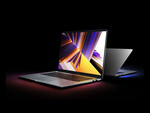Xiaomi RedmiBook 16 Series
 Processor: AMD Renoir (Ryzen 4000 APU) R5 4500U, AMD Renoir (Ryzen 4000 APU) R7 4700U, Intel Arrow Lake Ultra 5 225H, Intel Ice Lake i7-1065G7, Intel Raptor Lake-H i5-13500H
Processor: AMD Renoir (Ryzen 4000 APU) R5 4500U, AMD Renoir (Ryzen 4000 APU) R7 4700U, Intel Arrow Lake Ultra 5 225H, Intel Ice Lake i7-1065G7, Intel Raptor Lake-H i5-13500HGraphics Adapter: AMD Vega 6, AMD Vega 7, Intel Arc 130T, Intel Iris Xe G7 80EUs, NVIDIA GeForce MX350
Display: 16.00 inch, 16.10 inch
Weight: 1.6kg, 1.68kg, 1.76kg, 1.8kg
Price: 700, 1100 euro
Average of 1 scores (from 8 reviews)
Xiaomi RedmiBook 16 R5
Specifications
 Notebook: Xiaomi RedmiBook 16 R5
Notebook: Xiaomi RedmiBook 16 R5Processor: AMD Renoir (Ryzen 4000 APU) R5 4500U
Graphics Adapter: AMD Vega 6 512 MB
Display: 16.00 inch, 16:9, 1920 x 1080 pixels
Weight: 1.76kg
Links:
Price comparison
Reviews
A modern 6-core chip, aluminum housing, and a 512 GB SSD at a bargain price? In our review, we look at the entry-level configuration of the RedmiBook 16, currently only available in China or via import, and show where Xiaomi has cut corners.
Xiaomi RedmiBook 16 i7-1065G7, MX350
Specifications
 Notebook: Xiaomi RedmiBook 16 i7-1065G7, MX350
Notebook: Xiaomi RedmiBook 16 i7-1065G7, MX350Processor: Intel Ice Lake i7-1065G7
Graphics Adapter: NVIDIA GeForce MX350 2048 MB
Display: 16.10 inch, 16:9, 1920 x 1080 pixels
Weight: 1.8kg
Price: 1100 euro
Links:
Price comparison
Reviews
Source: Igeekphone
 Archive.org version
Archive.org versionIn terms of interaction, if you own a Xiaomi RedmiBook 16 2020 and also have a Xiaomi phone, it will become easier to transfer data in your daily office. RedmiBook 16 Ruilong version supports the Xiaomi mutual transfer function. After downloading the Xiaomi mutual transfer application, you can connect the computer to the mobile phone. The files transferred between the two are unlimited in format, unlimited number, and unlimited size. File transfer can also be achieved.
Single Review, online available, Long, Date: 07/08/2020
Xiaomi RedmiBook 16 R7 4700U
Specifications
 Notebook: Xiaomi RedmiBook 16 R7 4700U
Notebook: Xiaomi RedmiBook 16 R7 4700UProcessor: AMD Renoir (Ryzen 4000 APU) R7 4700U
Graphics Adapter: AMD Vega 7
Display: 16.10 inch, 16:9, 1920 x 1080 pixels
Weight: 1.8kg
Price: 700 euro
Links:
Price comparison
Reviews
Source: Gearbest
 Archive.org version
Archive.org versionThe highest evaluation of the RedmiBook 16 Ryzen Edition may be that it gave me an impulse to continue using it. After all, it can easily handle my daily text input and image processing needs. As far as the demand for notebooks is concerned, its performance is not inferior to other notebooks of the same price or even higher prices. Under the circumstance that can tolerate its above mentioned shortcomings, the RedmiBook 16 Ryzen Edition is indeed a notebook computer worth starting with.
Single Review, online available, Very Long, Date: 09/12/2020
Source: Gearbest
 Archive.org version
Archive.org versionThere are many positive aspects, for example, a large and convenient 16.1-inch screen with good brightness and color reproduction. In terms of games or complex programs, you should not worry, as it copes with them perfectly.
Single Review, online available, Long, Date: 07/28/2020
Source: TechTablets
 Archive.org version
Archive.org versionRedmibook 16 Review. Ryzen 7 4700U 16GB model with 46Wh battery, FHD 16.1" 100% sRGB screen, 512GB SATA3 SSD, and plenty of corners that have been cut on this one.
Single Review, online available, Very Long, Date: 06/29/2020
Source: TechTablets
 Archive.org version
Archive.org versionRedmibook 16 unboxing and detailed first look! AMD Ryzen 7 4700U model with 16GB DDR4 RAM, 512GB SSD, and 16.1" IPS matte screen.
Single Review, online available, Very Long, Date: 06/18/2020
Xiaomi Redmi Book 16 2024
Specifications
 Notebook: Xiaomi Redmi Book 16 2024
Notebook: Xiaomi Redmi Book 16 2024Processor: Intel Raptor Lake-H i5-13500H
Graphics Adapter: Intel Iris Xe G7 80EUs
Display: 16.00 inch, 16:10, 2560 x 1600 pixels
Weight: 1.68kg
Links:
Price comparison
Reviews
Source: Igeekphone

2560*1600 resolution, 120Hz refresh rate, 420nit brightness, 100% sRGB color gamut, and color accuracy of Delta E≈0.5. These parameters do not seem to be very outstanding, but a thin and light notebook with a price of 4,000 yuan can achieve these 5 at the same time. It can be said to be rare. Redmi Book 16 is available in two storage configurations: 512GB/1TB. The initial price is 4,399 yuan and 4,699 yuan respectively. At the same price, it is difficult to find a more value-for-money thin and light book.
Single Review, online available, Very Long, Date: 12/01/2023
Xiaomi RedmiBook 16 2025
Specifications
 Notebook: Xiaomi RedmiBook 16 2025
Notebook: Xiaomi RedmiBook 16 2025Processor: Intel Arrow Lake Ultra 5 225H
Graphics Adapter: Intel Arc 130T
Display: 16.00 inch, 16:10, 2560 x 1600 pixels
Weight: 1.6kg
Links:
Price comparison
Foreign Reviews
Source: WinFuture
 DE→EN
DE→ENSingle Review, online available, Very Short, Date: 05/15/2025
Comment
Xiaomi:
Founded in 2010, Xiaomi Corporation is a Chinese multinational electronics company and produces consumer electronics and related products, including smartphones, televisions, fitness bands, power banks, headphones, smart devices and accessories. Xiaomi offers its products under the Mi, Redmi and POCO brands.
Modern games should be playable with these graphics cards at low settings and resolutions. Casual gamers may be happy with these cards.
AMD Vega 6: Integrated graphics adapter of the Ryzen APUs based on the Vega architecture with 6 CUs (= 384 shaders) and a clock of up to 1,500 MHz.
NVIDIA GeForce MX350: Successor of the MX250 and most likely a renamed GeForce GTX 1050 based on the Pascal GP107 chip with 640 shaders and a 64 Bit memory bus for GDDR5.
AMD Vega 7: Integrated graphics adapter of the Ryzen APUs based on the Vega architecture with 7 CUs (= 448 shaders) and a clock speed of up to 1,600 MHz.
Intel Iris Xe G7 80EUs: Integrated graphics card in Intel Tiger Lake G7 SoCs based on the new Gen. 12 architecture with 80 EUs (Execution Units / Shader Cluster). The clock rate depends on the processor model. The Tiger Lake chips are produced in the modern 10nm+ process at Intel.
Intel Arc 130T: Integrated graphics unit of the Intel Arrow Lake H/HX CPU series. It is based on the Xe+ architecture and features 7 cores
» Further information can be found in our Comparison of Mobile Graphics Cards and the corresponding Benchmark List.
AMD Renoir (Ryzen 4000 APU):
R5 4500U: An upper mid-range, hexa-core APU designed for use in thinner, lighter laptops. The Ryzen features Zen 2 CPU cores running at 2.3 GHz to 4.0 GHz along with the Vega 6 graphics adapter (6 x 64 = 384 unified shaders). The thread-doubling SMT technology is not enabled in the case of Ryzen 5 4500U.
R7 4700U: A mobile Octa-Core APU with Zen 2 cores clocked at 2 to 4.1 GHz and a Vega graphics adapter with 7 CUs clocked at up to 1600 MHz. Compared to the faster 4800U, the 4700U offers a slightly lower boost clock speed and does not support SMT.
Intel Ice Lake:
i7-1065G7: Ice Lake-based quad-core processor for thin and light laptops. The four cores are clocked at 1.3 GHz to 3.9 GHz and should offer 18% more IPC (instructions per clock) than the previous generations (and therefore partly close the clock speed gap). Produced on first-gen 10 nm Intel process.
Intel Raptor Lake-H:
i5-13500H: On Alder-Lake based mobile CPU with 4 performance cores and 8 efficient cores. The performance cores offer hyper threading, leading to 16 threads that can be processed. The CPU clocks up to 4.7 GHz and supports vPro.
Intel Arrow Lake:
Ultra 5 225H: High-end mobile processor based on the Arrow Lake architecture with 14 of the 16 cores divided into 3 clusters. The fast 4 P-cores clock at up to 4.9 GHz. There are also 8 smaller E-cores with up to 4.3 GHz and 2 small low power cores (same architecture) with up to 2.5 GHz. It integrates a small NPU with 13 TOPS peak performance and supports vPro Essentials.
» Further information can be found in our Comparison of Mobile Processsors.
16.00:
This range for display formats was and is a rarity. It is larger than the general standard of 15 inches, but not yet in the range of large workstations. One usually has higher screen resolutions available, but portability suffers from that.
» To find out how fine a display is, see our DPI List.
No weight comment found (one expected)!
82.9%: This rating is slightly above average, there are somewhat more devices with worse ratings. However, clear purchase recommendations look different.
» Further information can be found in our Notebook Purchase Guide.




